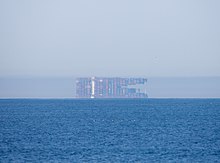
Back فاتا مورغانا Arabic Фата моргана Bulgarian Fata morgana Catalan Fata Morgana Corsican Fata morgána Czech Fata Morgana Welsh Fatamorgana (luftspejling) Danish Fata Morgana German Φάτα μοργκάνα (φαινόμενο) Greek Fatamorgano Esperanto


A Fata Morgana (Italian: [ˈfaːta morˈɡaːna]) is a complex form of superior mirage visible in a narrow band right above the horizon. The term Fata Morgana is the Italian translation of "Morgan the Fairy" (Morgan le Fay of Arthurian legend). These mirages are often seen in the Italian Strait of Messina, and were described as fairy castles in the air or false land conjured by her magic.
Fata Morgana mirages significantly distort the object or objects on which they are based, often such that the object is completely unrecognizable. A Fata Morgana may be seen on land or at sea, in polar regions, or in deserts. It may involve almost any kind of distant object, including boats, islands, and the coastline. Often, a Fata Morgana changes rapidly. The mirage comprises several inverted (upside down) and upright images stacked on top of one another. Fata Morgana mirages also show alternating compressed and stretched zones.[1]
The optical phenomenon occurs because rays of light bend when they pass through air layers of different temperatures in a steep thermal inversion where an atmospheric duct has formed.[1] In calm weather, a layer of significantly warmer air may rest over colder dense air, forming an atmospheric duct that acts like a refracting lens, producing a series of both inverted and erect images. A Fata Morgana requires a duct to be present; thermal inversion alone is not enough to produce this kind of mirage. While a thermal inversion often takes place without there being an atmospheric duct, an atmospheric duct cannot exist without there first being a thermal inversion.
- ^ a b An Introduction to Mirages by Andy Young
© MMXXIII Rich X Search. We shall prevail. All rights reserved. Rich X Search